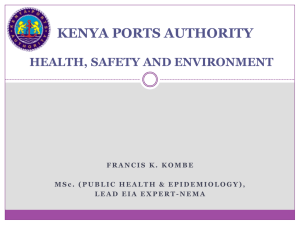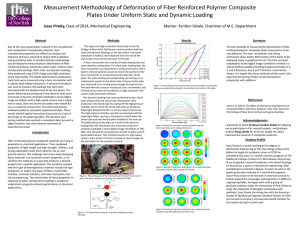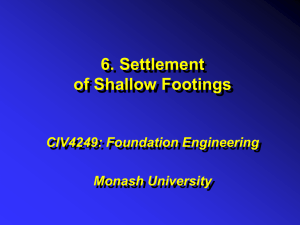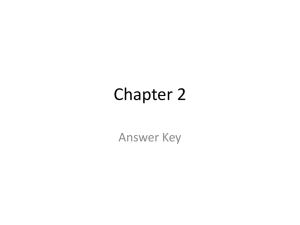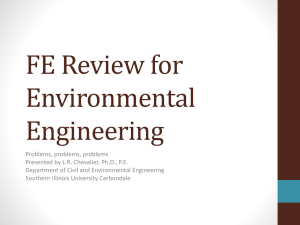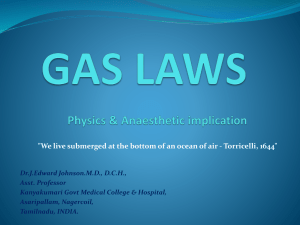Gas Laws Q4U1c
advertisement
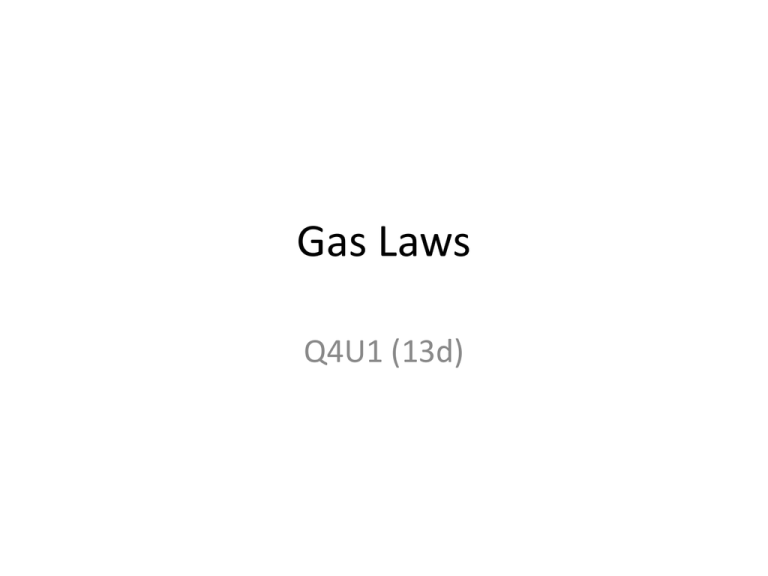
Gas Laws Q4U1 (13d) Gas Pressure • Gas Pressure is related to the mass of the gas and to the motion of the gas particles • Gas molecules move and bounce off the walls of their container – These collisions cause gas pressure • Pressure is a force per unit area – Standard Units of pressure = Pascal(Pa) – 1 Pa is the pressure of 1 Newton per square meter (N/m2) • Normal air pressure at sea level is 101.325 kilopascals (kPa) • 101.325 kPa = 760mm Hg, 1kPa = 7.5 mm Hg (1 kPa=1000Pa) – Other units of pressure, Atmosphere or psi • 1.00 atm = 760 mm Hg = 101.325 kPa =14.7 psi Atmospheric Pressure • The pressure exerted on the Earth by the gasses in the atmosphere • Absolute pressure will include the pressure on a closed system, as indicated by a gauge PLUS the pressure exerted by the atmosphere. Ex. The pressure gauge on a bicycle tire reads 44 psi, what is the absolute pressure? 44psi+14.7psi =59 psi Convert to kPa; 59 psi X (101.3kPa/14.7 psi) =410kPa Barometer vs. Manometer: Both measure pressure Barometer: is always closed end Calculations for Open Ended System • If mmHg is higher in open end • Pgas =Patmosphere + Ph3 Solve for gas pressure if: Ph3 = 185 mmHg Atmospheric pressure is 98.95 kPa 1. Convert mmHg to kPa # kPa = (185mm/1)(1kPa/7.50mm)=24.7 kPa 2. Add kPa to atmospheric pressure Pressure of gas = 98.95 +24.7= 124kPa Closed system: Used to measure pressure of a gas •The closed arm is filled with gas, what is the pressure of the gas, in kPa? •The difference in the Hg level is 165 mm •7.50 mm = 1 kPa Pressure of gas = (165.0 mm/1) ( 1kPa/7.5 mm) = 22.0 kPa Try some yourself 1. Closed manometer containing sulfur dioxide gas (SO2). Height difference in mmHg is 560, what is the pressure of SO2 in kPa? 2. An open monometer containing Hydrogen. Hg level is 78.0 mmHg in the arm connected to the air (open end), air pressure is 100.7kPa. What is the pressure of Hydrogen in kPa? 3. An open monometer containing Nitrogen. Hg level is 26.0 mmHg in the arm connected to the gas, air pressure is 99.6kPa. What is the pressure of nitrogen in kPa? Answers 1. Pressure of SO2 = (560.0 mm/1) ( 1kPa/7.5 mm) = 74.6 kPa 2. # kPa = (78.0mm/1)(1kPa/7.50mm)=10.4 kPa Pressure of H2= 100.7kPa + 10.4kPa= 111.1 kPa 3. # kPa= (26.0mm/1)(1kPa/7.50mm)= 3.47kPa Pressure of N2 = -3.47kPa + 99.6 =96.1kPa notice the negative number, less than air pressure Homework • Complete section review #1-8 handout p 73 Mathematic Relationships There is a Mathematical Relationship between Pressure, Temperature and Volume of a constant amount of gas • Gas volumes change significantly with small changes in temperature and pressure • These changes can be defined by equations called the gas laws. • Gas laws are only valid for ideal gasses • Ideal gases: do not exist, but are a model, they have no attractive force and no volume Boyle’s Law; Relates Pressure and Volume • If the pressure on an ideal gas is increased, the volume decreases • When the pressure is doubled ( ), the volume of the gas is half ( ) what it was • If the pressure is cut( ) by half, the volume is doubled ( ). Boyle’s Law: GAS VOLUME AND PRESSURE, at constant temperature, ARE INVERSELY PROPORTIONAL! ( ) (when one goes up the other goes down) – To find the new volume, you need the original volume AND the change in pressure V2 = V1 X P1/P2 – To find new pressure, you need the original pressure AND the change in volume --- New pressure = old pressure X volume Ratio P2 = P1 X V1/V2 - Mentally decide if the new volume is larger or smaller than the old, arrange the pressure ratio accordingly (If larger use fraction greater than 1, If smaller use fraction less than 1) Boyle’s Law Example Problems 1. If 425 mL of O2 are collected at a pressure of 9.80 kPa what volume will the gas occupy if the pressure is changed to 9.40 kPa? • the pressure decreases from 9.8 to 9.4 kPa. (V will increase) V2 = V1 X P1/P2 (425mL/1) ( 9.8 kPa/9.4 kPa) = 443.0 mL 2. Calculate the pressure of a gas that occupies a volume of 125.0 mL, if at a pressure of 95.0 kPa, it occupies a volume of 219.0 mL. • the volume decreases from 219.0 mL to 125.0mL.(P will increase) P2 = P1 X V1/V2 (95.0 kPa/1) (219.0 mL/125.0mL) = 166.0 kPa Charles’s Law; relates Temperature and Volume • In an ideal gas, with constant pressure, if the temperature increases the volume will increase. • Charles’s Law: at a constant pressure, the volume of a gas is directly proportional to its Kelvin temperature. (you must express temp in degrees K) • New volume =old volume X degree K temp change V2 = V1 X T2/T1 • New temperature = old temp (K) X volume change T2 = T1 X V2/V1 - Mentally decide if the new volume is larger or smaller than the old, arrange the pressure ratio accordingly (If larger use fraction greater than 1, If smaller use fraction less than 1) Charles’s Law Example Problem 1. What volume will a sample of nitrogen occupy at 28.0 degrees C if the gas occupies a volume of 457 mL at a temperature of 0.0 degrees C? Assume the pressure remains constant. convert temp to K K= 273 + degrees C K = 273 + 28.0 degrees C = 301 K and K = 273 + 0.0 C = 273 K (Temp increase means Volume increase: Ratio > than 1) New Volume = (457mL/1) (301 k/273 k) = 504 mL Charles’s Law Example Problem #2 2. If a gas occupies a volume of 733 mL at 10.0 dC, at what temperature in C degrees, will it occupy a volume of 1225 mL if the pressure remains constant? (increased volume means increased temperature) Convert °C to °K (°K = °C + 273) 10.0 °C = 283 °K T2 = T1 X V2/V1 = (283 °K/1) (1225 mL/733 mL) = 473 °K Convert °K to °C °C = 473 K – 273 = 200 °C Practice use of Boyle’s Law • Complete the problem solving packet, Pg 1216; problems 1-5 all parts • Show all work • Label all units • Due tomorrow (complete for homework if necessary) Practice use of Charles’s Law • Complete the problem solving packet, Pg 17-20 problems 1-3 all parts • Show all work • Label all units • Due tomorrow (complete for homework if necessary) Combined Gas Law: when both temperature and pressure change occur • Boyle’s and Charles’s laws used together make the combined gas law. • A pressure ratio and a Kelvin temperature ratio are needed to calculate the new volume. New Volume = old volume X pressure ratio X Kelvin temperature ratio V2 =V1(P1/P2)(T2/T1) *STP=273K and 101.3kPa • First: Construct a press-volume-temp data table Value P V T Old Conditions New Conditions What happens to gas Volume? Practice: Combined Gas Law Calculate the volume of a gas at STP if 502 mL of the gas are collected at 29.7 C and 96.0 kPa •Convert Celsius to Kelvin temps. ( 29.7 + 273 = 302.7) •Organize the data in the table. Value Old Conditions New Conditions What happens to gas Volume? P V T 96.0 kPa 502 mL 302.7 K 101.3 kPa ? 273 K Decrease ? Decrease Calculate: V2 =V1(P1/P2)(T2/T1) V2 = 502 mL ( 96.0kPa/ 101.3kPa) (273K/ 302.7k) V2 = 429 mL Try this on your own! • If 400 ml of oxygen are collected at 20.0C, and the atmospheric pressure is 94.7 kPa, what is the volume of the oxygen at STP? Value Old Conditions New Conditions What happens to gas Volume? P V T 94.7 kPa 400. mL 293 K 101.3 kPa ? 273 K Decrease ? Decrease V2 =V1(P1/P2)(T2/T1) = 400 mL (94.7 kPa/101.3 kPa) (273 k/293 K) = 348 mL Homework: Complete Handout, Pg 78-79 • • • • #’s 10-14, all parts Show all of your work label all of your units DUE TOMORROW!!! Gay- Lussac’s Law: relates Temperature and pressure • The Pressure of a gas is DIRECTLY proportional to the absolute temperature when the volume is unchanged. • P1T2=P2T1 or P1 = P2 T1 T2 • When temp increases, pressure increases • Must use Kelvin temperatures! Gay- Lussac’s Law Example A cylinder of gas has a pressure of 4.40 atm at 25 C. At what temperature, in Celsius, will it reach a pressure of 6.50 atm? P1 = 4.40atm P1T2=P2T1 T2= ? K and ?C 298 X 6.50 atm = 440 K P2 = 6.50 atm 4.40 atm T1 = 25+273=298 K 440.K = (440. – 273) C =167°C Practice Problems; Gay- Lussac’s Law • Complete the problem solving packet, Pg2024, problems 1-3 all parts • Show all work • Label all units Avogadro’s Law; relates volume to moles • Avogadro's Law states: for a gas at constant temperature and pressure, the volume is directly proportional to the number of moles of gas. • Avogadro's law relates the quantity of a gas and its volume. • According to Avogadro's Law: V1n2 = V2n1 • When any three of the four quantities in the equation are known, the fourth can be calculated. – For example, if n1, V1 and V2 are known, the n2 can be solved by the following equation: – n2 = V2 x (n1/V1) Avogadro’s Law Practice • Example #1: 5.00 L of a gas is known to contain 0.965 mol. If the amount of gas is increased to 1.80 mol, what new volume will result (at an unchanged temperature and pressure)? • Answer: this time I'll use V1n2 = V2n1 • (5.00 L) (1.80 mol) = (x) (0.965 mol) Avogadro’s Law Practice Example #2: A cylinder with a movable piston contains 2.00 g of helium, He, at room temperature. More helium was added to the cylinder and the volume was adjusted so that the gas pressure remained the same. How many grams of helium were added to the cylinder if the volume was changed from 2.00 L to 2.70 L? (The temperature was held constant.) Solution: 1) Convert grams of He to moles: 2.00 g / 4.00 g/mol = 0.500 mol 2) Use Avogadro's Law: V1/n1 = V2/n2 2.00 L / 0.500 mol = 2.70 L / x x = 0.675 mol 3) Compute grams of He added: 0.675 mol - 0.500 mol = 0.175 mol 0.175 mol x 4.00 g/mol = 0.7 grams of He added Progression of Laws • Boyles', Charles', and Avogadro's laws combine to form the ideal gas law, which is the uber law of gases. • The ideal gas law can be manipulated to explain Dalton's law, partial pressure, gas density, and the mole fraction. It can also be used to derive the other gas laws. Ideal Gas Law • The ideal gas law is an ideal law. It operates under a number of assumptions. • The two most important assumptions are that the molecules of an ideal gas do not occupy space and do not attract each other. • These assumptions work well at the relatively low pressures and high temperatures, but there are circumstances in the real world for which the ideal gas law holds little value. Ideal Gas Law • Equation: PV = nRT P is pressure in kPa V is volume in cubic decimeters T is temperature in K n represents the number of moles of the gas R is a constant , using these units, is 8.31 L kPa/mol K (R can have different units when needed) • This equation can be used to determine the molecular mass of a gas – Moles (n) = mass(m)/ molecular mass(M) PV = m RT M Amount of Gas Present • Amount of gas present is related to its pressure, temperature and volume using the Ideal Gas Law • Applying the gas law allows for the calculation of the amount of gaseous reactants and products in reactions Application Of Gas Laws Example 1. How many moles of gas will a 1250 mL flask hold at 35.0 degrees C and a pressure of 95.4 kPa? PV=nRT or n = PV RT Convert degree C to Kelvin, 35.0C = 273+ 35.0 = 308K n = PV RT n= 95.4 kPa 1250 mL 1L 8.31 L kPa/mol K 308 K 1000 mL n= 0.0466 mol Gas Laws Example 2 2. A flask has a volume of 258 mL. A gas with mass 1.475 g is introduced into the flask at a temperature of 302.0 K and a pressure of 9.86 x104 Pa. Calculate the molecular mass of the gas using the ideal gas equation. n= mass/molecular mass(M) M = mRT PV M= 1.475 g 8.31 L kPa 302.0 K 1000 mL 1000 Pa 9.86 x104 Pa mol K 258 mL 1L 1kPa M= 146.0 g/mol Ideal Gas Law Problems 1. How many moles of He are contained in a 5.00L canister at 101 kPa and 30.0 dC? 2. What is the volume of 0.020 mol Ne at 0.505 kPa and 27.0 dC? 3. How much Zn must react in order to form 15.5 L of H2 gas at 32.0 dC and 115 kPa? Zn + H2SO4 ZnSO4 + H2 Ideal Gas Law Problem Solutions 1. How many moles of He are contained in a 5.00L canister at 101 kPa and 30.0 dC? n= VP/RT (5.00 L) (101 kPa) ( 8.31 kPa L) 303 K (1 mol K) = 5.0 X 101 X 1 mol 8.31 X 303 = 0.201 mol Ideal Gas Law Problem Solutions 2. V= nRT P V = ( 0.020 mol Ne) (8.31 kPa L) (300 K) ( 1 mol K) 0.505 kPa V= 99 L Ne Ideal Gas Law Problem Solutions 3. First determine moles PV=nRT n=PV n= (115 kPa) ( 15.5 L) RT ( 8.31 kPa L) (305) ( 1 mol K ) n= 0.703 mol H2 Now determine mass of Zn (molar ratio and molar mass) (0.703 mol H2) (1 mol Zn) ( 65.39 g Zn) (1) (1 mol H2) ( 1 mol Zn) = 46.0 g Zn Compare and Contrast gas Laws Gas Law Relates Equation Unit Boyle’s Pressure to Volume P1V1=P2V2 L or kPa Charles’s Temperature to Volume T1V2=T2V1 K or L Combined Gas law Temperature, pressure and volume V2 =V1(P1/P2)(T2/T1) K, L and kPa Gay- Lussac’s Law Temperature and pressure P1T2=P2T1 K or kPa Avogadro’s Law volume to moles V1 / n 1 = V 2 / n 2 kPa or mol Ideal gas Law Pressure, volume, temp and moles PV=nRT and PV = m RT M Mol, L, K, or kPa

